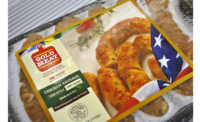Frozen for Health
Those who consumed frozen meals consumed 253 fewer calories than those who consumed a quick service restaurant meal.

San Diego/Press Release -- New analysis of data from the 2003-2010 What We Eat In America (WWEIA) National Health and Nutrition Examination Survey (NHANES), a program of the Centers for Disease Control and Prevention (CDC), indicates that consumers of frozen meals compared to consumers of quick service restaurant (QSR) meals had lower calorie intakes and better Healthy Eating Index (HEI) score. In fact, the analysis revealed that those who consumed frozen meals consumed 253 fewer calories than those who consumed a quick service restaurant meal.
"The analysis shows consumers of frozen meals come a little closer to meeting Dietary Guidelines for Americans than consumers of quick service restaurant meals, and they do it with 253 fewer calories a day," said Dr. Victor L. Fulgoni, co-author of the analysis and vice president of Nutrition Impact, LLC.
Specifically, the analysis revealed that those who consumed frozen meals, when compared to those who consumed QSR meals, had significantly:
- lower calorie intake (2073±51 kcal/d frozen meal consumers vs 2326±20 QSR consumers)
- higher total Healthy Eating Index (HEI) score (53.0±1.5 frozen meal consumers vs 44.4±0.4 QSR consumers)
- higher intakes of total vegetables (3.4±0.1 frozen meal consumers vs 2.9±0.03 QSR consumers)
- higher intakes of greens and beans (1.7±0.2 frozen meal consumers vs 0.9±0.04 QSR consumers)
- higher intakes of whole grains (2.9±0.3 frozen meal consumers vs 1.8±0.1 QSR consumers)
- higher intakes of total protein foods (4.4±0.1 frozen meal consumers vs 4.1±0.03 QSR consumers)
- lower intakes of refined grains (6.6±0.4 frozen meal consumers vs 5.4±0.1 QSR consumers)
- lower intakes of empty calories (13.1±0.5 frozen meal consumers vs 9.9±0.2 QSR consumers)
"We are excited about the results of this study as it shows that frozen meals can play an important role in helping Americans meet the US Dietary Guidelines," said Kim Krumhar, Ph.D., Scientific Advisor – Nutrition, Nestlé.
Looking for a reprint of this article?
From high-res PDFs to custom plaques, order your copy today!





